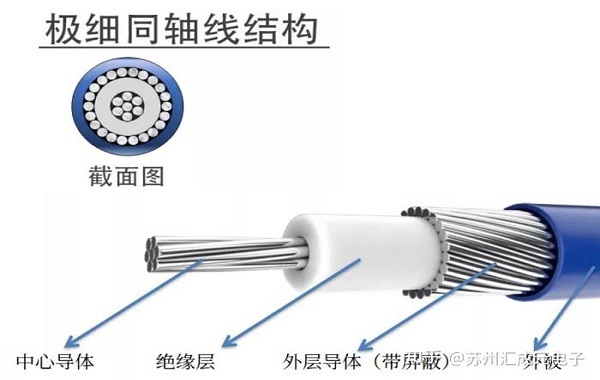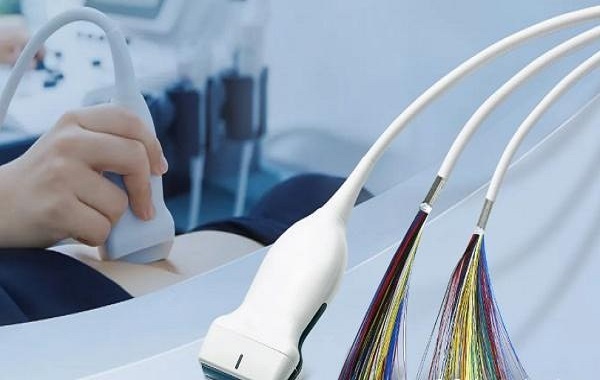Categorization:Harness Component
With the continuous development of modern electronic devices towards miniaturization, lightweight, and high-speed transmission, ultra-fine coaxial cables (Micro Coaxial Cable) have become key internal connection components in devices such as smartphones, medical endoscopes, security modules, drones, and high-end laptops. Especially, ultra-fine coaxial cables with a wire diameter of only 0.18mm represent the ultimate process level of cable manufacturing. How is such a fine structure achieved? This article will analyze from three aspects: structural principle, manufacturing process, and application value.

An Analysis of the Structure of Extremely Fine Coaxial Lines
Although the appearance is as fine as a hair, the internal structure of the extremely fine coaxial line is precise and complex. It is usually composed of the following four parts:
Inner conductor
The core part uses silver-plated copper or copper alloy conductors with a diameter of only 0.03mm to 0.05mm, which have excellent electrical conductivity and high-frequency response capabilities.
Insulation layer
Utilizing high-frequency materials such as polytetrafluoroethylene (PTFE) and fluoroethylene propylene (FEP), with a thickness controlled at the micron level, it ensures both electrical performance and cable flexibility.
3. Shielding layer
To suppress electromagnetic interference (EMI), fine copper wire braiding or aluminum foil wrapping is used, and some high-end products adopt multi-layer composite shielding structures to achieve excellent signal integrity.
Outer sheath
The outer layer is mainly made of thin and light materials such as PEEK and PU, which have features of wear resistance, flexibility, and bend resistance.
To compress the structure to a bus diameter of 0.18mm means that the processing accuracy of each layer must reach the micro or even sub-micrometer level, which places extremely high requirements on manufacturing equipment and process control.

The combination of precision and cleanliness in manufacturing technology
The manufacturing process of ultra-fine coaxial cables is a concentrated manifestation of "micrometer-level engineering."
Conductor Drawing and Shaping
Using a multi-pass high-speed drawing machine, the coarse copper wire is drawn below 0.03mm, while ensuring the surface smoothness and concentricity are consistent, to avoid signal center offset.
Insulation layer micro-extrusion
Utilize high-precision micro extrusion equipment in a恒温clean room environment to cover the conductor with a uniform insulating layer, with the thickness error controlled within ±1μm to ensure stable characteristic impedance.
3.屏蔽层绕包与编织Shielding layer wrapping and weaving
Due to the extremely thin wire diameter, traditional weaving methods are no longer applicable, and manufacturers mostly use a wrapping aluminum foil + micro-weaving hybrid process to achieve high-density shielding.
4. Extrusion and Tension Control of the Outer Sheath
The sleeve must be both thin and durable. During production, real-time monitoring of temperature, tension, and line speed is used to prevent core breakage or eccentricity due to uneven stress.
5. Product Inspection and Automated Processing
After manufacturing, the product is fully inspected by a high-magnification CCD vision detection system and an impedance tester. Automated cutting and winding ensure consistency and reliability in dimensions.
Why to be so detailed
The existence of ultra-fine coaxial lines is an inevitable result of addressing the challenges of internal connections in high-density electronic devices.
Medical field
In minimally invasive endoscopic and diagnostic equipment, a 0.18mm wire diameter can penetrate extremely small channels to achieve precise signal transmission.
Consumer electronics and security modules
Smart camera lenses, tablet computers, and AR/VR devices have extremely limited lens and motherboard spaces. Ultra-fine cables can achieve a balance between high-speed signals and compact layouts.
High-speed signal system
MIPI, USB 3.1, Thunderbolt, and other interfaces have extremely high requirements for impedance and shielding performance. Extremely thin coaxial cables with flexibility, high-frequency characteristics, and anti-interference properties have become an ideal solution.
Compared with traditional FPC (Flexible Printed Circuit) or FFC (Flat Cable), ultra-fine coaxial cables have obvious advantages in high-speed differential signal transmission and signal integrity control.
The ultra-fine coaxial cable with a wire diameter of only 0.18mm is not only the result of advanced materials and micro-scale manufacturing processes, but also represents the future direction of high-speed interconnect technology. Every link, from conductor drawing, insulation extrusion to shielding wrapping, needs to be completed with extremely high precision. It makes electronic devices lighter, faster, and smaller while maintaining the stability and reliability of high-frequency signal transmission.
I am[Suzhou Huichengyuan Electronic Technology], long-term focused on the design and customization of high-speed cable harnesses and ultra-thin coaxial cables, committed to providing customers with stable and reliable high-speed interconnection solutions. For more product information or technical support, please contact:Manager Zhang 18913228573 (WeChat same number)。